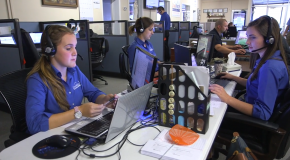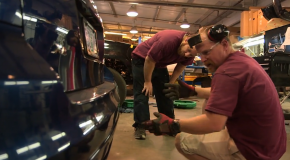Sharp Decisions, New York
Like many firms in its industry, Sharp Decisions, a technology consultancy in New York City, faces a tough battle for talent. Sharp, with about 400 consultants, generates roughly $60 million in annual revenue and has made Inc. magazine’s “500|5,000 list of the nation’s fastest-growing privately held companies” in recent years.
But CEO Karen Ross, who founded Sharp in 1990, had a plan to fill her pipeline—and a purpose. She knew that veterans often struggle in the job market.
So, in March 2013, Ross launched the Vocations, Education and Training for Service Members (V.E.T.S.) program and invited veterans to apply. “I decided it was time to step up, bring jobs back to America and bring these young people an opportunity for a future,” says Ross, who runs one of New York City’s largest women-owned businesses.
Today, 32 percent of Sharp’s new hires in the program are vets ages 30 and under. They’re trained in a boot-camp-like program that leads to a career path in four to six weeks and work for high-profile clients like Freddie Mac, EmblemHealth and Experian. The specialized skills they learn help them secure a professional future in a field that often excludes those without connections to the technology community.
Sharp has completed five training classes and trained 50 veterans so far, and Ross expects to run two more sessions this year to grow its veteran ranks fourfold, to 200, by year’s end. Ross believes this ambitious goal is achievable “if I can get some clients to understand it’s an absolute win.” The ready-made pool of eager, trainable talent also means Ross doesn’t have to wait months—or wrestle with endless red tape—to secure visas for technology-savvy immigrants, as is common in the technology industry.
Paid squad-based training, marketable skills
Through the V.E.T.S. program, Ross offers returning veterans paid training in quality assurance (QA) and software testing. Veterans are placed on a sample project to evaluate their skills. If trainees are not ready, coursework continues. Once they have achieved and demonstrated competency, they are deployed in teams of three or more to her clients’ offices. This is by design: Ross believes they will be more comfortable in a unit, as in the military. Such an approach when run with assistance from well-trained professionals could be highly effective with other group-oriented recruits, including rehabilitated former gang members, in other endeavors. Members motivate and teach one another because the group does not move on until everyone “gets it.”
Veterans receive a performance review at the completion of a project or client assignment program managers, with input from clients.
Every veteran is a full-fledged employee from the first day. Trainees earn wages commensurate with their experience and skill level. In most cases, those who finish the training program are considered entry-level. QA testing is a job with salaries that start at $43,000 and hit a median of about $60,000 in New York City, according to Glassdoor. Participating veterans include high school, military academy and college graduates.
Sharp understands that veterans may face post-deployment health issues and encourages its clients to be flexible when these needs arise. The company also strives to provide veterans with a job after they return if they are redeployed.
Freddie Mac, EmblemHealth among clients
To date, client Freddie Mac, in McLean, Virginia, has hired 10 veterans from the V.E.T.S. program. They worked under the direction of Tim Snyder, a vice president who is Freddie Mac’s head of software testing and an Operation Desert Storm veteran. The company found the veterans “very focused,” says Jane F. Moya, a spokesperson. “They understood what they had to learn and do to get the job done.” Now that the program is up and running, with a good track record and satisfied clients, Ross wants to scale it up. All new vets trained have a placement waiting for them.
One of these veterans is Brooklyn, New York resident Ethan Israel, now 25, who joined the inaugural training class in 2013. He and three other veterans consulted for EmblemHealth.
Israel didn’t expect to go into software testing. After serving in the National Guard in Afghanistan, he waited tables in his hometown of Dallas, but wanted something with a future. He moved to New York City and following two months of unemployment applied for and was accepted to the V.E.T.S. program.
“I was apprehensive,” says Israel, who studied business and air traffic control at the University of Oklahoma before his deployment, but never earned his degree. “I didn’t have an extensive tech background. [But] they started from square one and taught us the entire process.”
Israel still works at EmblemHealth, where he says his assignment has given him confidence. “I think the team aspect really helped,” he observes. “If we had any kind of issues or wanted to consult over anything or learn, we had a group to rely on. It helps me to not be afraid of getting in over my head.” He plans to continue in a technology career and to finish his college degree.
Speed bumps
Ross took a leap of faith to start V.E.T.S and now syncs her hiring efforts to advance commitments from companies to host the veterans. Ross relies on her quality assurance manager to train and mentor the veterans in quality assurance and testing in various locations, including rented and donated space; she also serves as a liaison to the companies that hire them.
Sometimes she’s hit obstacles. Not every veteran could handle the rigorous program. The first training group started with 18 veterans, but one dropped out and two didn’t pass the program requirements. Ross thought it would be easy to win business, but many clients preferred cheaper quality-assurance solutions—like outsourcing overseas. Some didn’t want to commit to hiring several veterans at one time, which Ross insisted on.
“This is so right on so many levels: It’s a win for the kids, it’s a win for me and for the client,” says Ross, “but it was incredibly difficult to get anyone interested in the program.” For five months, she paid the veterans to do lab work and projects for Sharp Decisions in a conference room.
Competitive application process
Sharp Decisions finds veterans through job boards like Monster.com and the Hiring Our Heroes website, then screens potential trainees in a series of interviews. The competitive application process includes a search for soft skills—Ross recognized that clients expected excellent service.
“I don’t care if they have a college degree,” says Ross. “Can they present? Can they articulate what their skills are? Can they look you in the eye and shake your hand?” She asked them to make a minimum one-year commitment.
Big upfront investment; ready, rotational talent pool
Growing the program has required Ross to invest more than $1 million in salaries, benefits and training-related costs; she defrays some of the overhead through client billings and is looking to break even by the first quarter of 2015—two years after the program’s inception. Ross says that the program could be replicated on any size budget because the extent of the training and caliber of the trainees is pegged to client commitments.
Despite a model that is financially sustainable—hiring growth is matched to the willingness of companies to host the vets—she has had to accept that sometimes her best-laid plans get disrupted.
Some are reservists, she says. “I have one that was just deployed for 300 days. He is a Black Hawk helicopter pilot. He was called to duty and that was that.”
Ross tries to keep a job waiting for veteran when they return. “I made a promise: If you commit to me, I will commit to you,” she says.
|
Sharp Decisions—Highlights |
|
Why hire youth? CEO Karen Ross wanted to create jobs for veterans and win the war for talent with an eager, ready pool of workers. |
|
Innovation: A squad-based approach, where the team moves on only after everyone “gets it.” |
|
Investment: Roughly $1 million since 2013; recouping some costs through work the veterans do for clients helps defray costs. Avoiding high visa procurement fees to hire tech-savvy immigrants (common in the industry) also keeps costs down. Ross expects to break even by 2015. |
|
Investment sources: Operating revenue |
|
Social impact: Veterans, some of whom are high school grads, gain entry into the tech world and lucrative career opportunities in a field that often excludes non-college-educated workers. |
|
Veterans ages 30 and underemployed: 15 (32% of V.E.T.S. workforce) |
|
Retention rate: 100% among those who have successfully completed the program |
|
Future plans: Sharp has completed five training classes and expects to run two more this year. Ross hopes to train 200 veterans by year’s end as word spreads about its model and business. |







